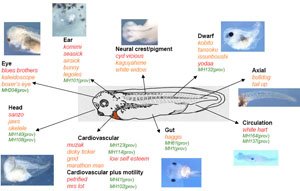Uncovering Gene Functions With A New Vertebrate Model
 Genetic and genomic data provide the foundations for contemporary biological research, and assigning functions to genes is fundamental to understanding health and disease. The Wellcome Trust Sanger Institute has made a significant contribution to the genome sequences of many model organisms and has implemented a number of programmes to use these sequences to understand gene function.
Genetic and genomic data provide the foundations for contemporary biological research, and assigning functions to genes is fundamental to understanding health and disease. The Wellcome Trust Sanger Institute has made a significant contribution to the genome sequences of many model organisms and has implemented a number of programmes to use these sequences to understand gene function.
In a report published online in PLoS Genetics, a team from the Sanger Institute, together with colleagues from the National Institute for Medical Research, describe a new initiative designed to analyse function of a wide variety of genes in the frog Xenopus tropicalis. X. tropicalis, unlike its well-studied cousin Xenopus laevis, has a simple genome structure, and has been recently adopted for laboratory research.
By applying cutting-edge genetic methods to X. tropicalis‘ easily studied embryos, the newly-published study offers new insights into many different processes in the early development of vertebrate embryos, and begins to identify genes implicated in the formation of heart, blood, eyes and ears, as well as the function of the nervous system.
Amphibian embryos can be used to understand how all vertebrates, including mammals, develop from fertilized single-celled eggs to establish a body plan and form different cell types and functional organs. Xenopus tropicalis has a relatively short generation time, simple genetic structure, and an easily studied, externally developing embryo.
Genetic methods are used to analyze what goes wrong in embryos lacking working versions of individual genes, and hence to understand better the specific functions of those genes. However, genetic analysis of other amphibian species has been difficult because of their long generation time and complex genetic structure.
The team describe new established methods for systematically studying disrupted genes in X. tropicalis, using both forward genetics (where the effects of a mutation on the embryo are first characterized, then the DNA defect is later identified) and reverse genetics (where animals carrying mutations in a known DNA sequence are first identified, and the effects of that mutation are characterized subsequently).
In the forward genetic screen, they have uncovered 77 candidate phenotypes in diverse organogenesis and differentiation processes. They also demonstrated the feasibility of reverse genetic approaches for obtaining carriers of mutations in specific genes by recovery of an identified mutation of interest.
The X. tropicalis system offers a unique opportunity to combine forward and reverse genetic and genomic approaches with classical embryological, molecular, and gain-of-function analytical techniques in a single model vertebrate embryo.
More information
Publications:
Selected websites
The Wellcome Trust Sanger Institute
The Wellcome Trust Sanger Institute, which receives the majority of its funding from the Wellcome Trust, was founded in 1992. The Institute is responsible for the completion of the sequence of approximately one-third of the human genome as well as genomes of model organisms and more than 90 pathogen genomes. In October 2006, new funding was awarded by the Wellcome Trust to exploit the wealth of genome data now available to answer important questions about health and disease.
The Wellcome Trust and Its Founder
The Wellcome Trust is the most diverse biomedical research charity in the world, spending about £450 million every year both in the UK and internationally to support and promote research that will improve the health of humans and animals. The Trust was established under the will of Sir Henry Wellcome, and is funded from a private endowment, which is managed with long-term stability and growth in mind.


